Ta Doping Effect on Structural and Optical Properties of InTe Thin Films
Abstract
1. Introduction
2. Experimental Details
3. Results and Discussion
3.1. XRD Analysis
3.2. Raman Spectral Analysis
3.3. SEM, EDS, and XPS Analysis
3.4. Linear Optical Analysis
3.5. Nonlinear Optical Analysis
4. Summary
Author Contributions
Funding
Acknowledgments
Conflicts of Interest
References
- Chen, Y.; Sun, L.; Zhou, Y.; Zewdie, G.M.; Deringer, V.L.; Mazzarello, R.; Zhang, W. Chemical understanding of resistance drift suppression in Ge-Sn-Te phase-change memory materials. J. Mater. Chem. C 2020, 8, 71–77. [Google Scholar] [CrossRef]
- Cao, X.; Meng, C.; Li, J.; Wang, J.; Yuan, Y.; Su, J.; Liu, C.; Zhang, X.; Zhang, H.; Wang, J. Characterization of interfacial barrier charging as a resistive switching mechanism in Ag/Sb2Te3/Ag heterojunctions. Phys. Chem. Chem. Phys. 2018, 20, 18200–18206. [Google Scholar] [CrossRef]
- Wang, J.; Jin, F.; Cao, X.; Cheng, S.; Liu, C.; Yuan, Y.; Fang, J.; Zhao, H.; Li, J. In2Te3 thin films: A promising nonlinear optical material with tunable nonlinear absorption response. RSC Adv. 2016, 6, 103357–103363. [Google Scholar] [CrossRef]
- Hajijafarassar, A.; Martinho, F.; Stulen, F.; Grini, S.; Lopez-Marino, S.; Espindola-Rodriguez, M.; Doebeli, M.; Canulescu, S.; Stamate, E.; Gansukh, M.; et al. Monolithic thin-film chalcogenide-silicon tandem solar cells enabled by a diffusion barrier. Sol. Energy Mater. Sol. Cells 2020, 207, 110334. [Google Scholar] [CrossRef]
- Huang, W.; Gan, L.; Li, H.; Ma, Y.; Zhai, T. 2D layered group IIIA metal chalcogenides: Synthesis, properties and applications in electronics and optoelectronics. CrystEngComm 2016, 18, 3968–3984. [Google Scholar] [CrossRef]
- Hogg, J.H.C.; Sutherland, H.H. Indium Telluride. Acta Crystallogr. Sect. B Struct. Sci. 1976, 32, 2689–2690. [Google Scholar] [CrossRef]
- Rajaji, V.; Pal, K.; Sarma, S.C.; Joseph, B.; Peter, S.C.; Waghmare, U.V.; Narayana, C. Pressure induced band inversion, electronic and structural phase transitions in InTe: A combined experimental and theoretical study. Phys. Rev. B 2018, 97, 155158. [Google Scholar] [CrossRef]
- Geller, S.; Jayaraman, A.; Hull, G.W. Crystal chemistry and superconductivity of pressure-induced phases in the InTe system. J. Phys. Chem. Solids 1965, 26, 353–361. [Google Scholar] [CrossRef]
- Jana, M.K.; Pal, K.; Waghmare, U.V.; Biswas, K. The Origin of ultralow thermal conductivity in InTe: Lone-pair-induced anharmonic rattling. Angew. Chem. Int. Ed. 2016, 55, 7792–7796. [Google Scholar] [CrossRef]
- Tritt, T.M. Thermoelectrics run hot and cold. Science 1996, 272, 1276–1277. [Google Scholar] [CrossRef]
- Peng, Q.; Xiong, R.; Sa, B.; Zhou, J.; Wen, C.; Wu, B.; Anpo, M.; Sun, Z. Computational mining of photocatalysts for water splitting hydrogen production: Two-dimensional InSe-family monolayers. Catal. Sci. Technol. 2017, 7, 2744–2752. [Google Scholar] [CrossRef]
- Peng, Q.; Wang, Z.; Sa, B.; Wu, B.; Sun, Z. Electronic structures and enhanced optical properties of blue phosphorene/transition metal dichalcogenides van der Waals heterostructures. Sci. Rep. 2016, 6, 31994. [Google Scholar] [CrossRef] [PubMed]
- Sowjanya, V.; Bangera, K.V.; Shivakumar, G.K. Synthesis of single-phase stoichiometric InTe thin films for opto-electronic applications. Superlattices Microstruct. 2019, 129, 220–225. [Google Scholar] [CrossRef]
- Sugiyama, Y.; Chiba, R.; Fujimori, S.; Funakoshi, N. Crystallization process of In-Te alloy-films for optical-recording. J. Non-Cryst. Solids 1990, 122, 83–89. [Google Scholar] [CrossRef]
- Yuan, Y.; Liu, C.; Su, J.; Cheng, L.; Fang, J.; Zhang, X.; Sun, Y.; Wu, Y.; Zhang, H.; Li, J. Structural and Optical Properties of Ti-Doped InTe Thin Films. J. Phys. Chem. C 2018, 122, 6267–6272. [Google Scholar] [CrossRef]
- Li, H.; Zhou, Z.; Wang, H. Tunable Schottky barrier in InTe/graphene van der Waals heterostructure. Nanotechnology 2020, 31, 335201. [Google Scholar] [CrossRef]
- Back, S.Y.; Kim, Y.-K.; Cho, H.; Han, M.-K.; Kim, S.J.; Rhyee, J.S. Temperature-induced lifshitz transition and charge density wave in InTe1-δ thermoelectric materials. ACS Appl. Energy Mater. 2020, 3, 3628–3636. [Google Scholar] [CrossRef]
- Pan, S.; Liu, H.; Li, Z.; You, L.; Dai, S.; Yang, J.; Guo, K.; Luo, J. Enhancement of the thermoelectric performance of InTe via introducing Cd dopant and regulating the annealing time. J. Alloys Compd. 2020, 813, 152210. [Google Scholar] [CrossRef]
- Cheng, S.; Wei, S.; Yi, X.; Wang, J.; Liu, C.; Li, J.; Yang, T. Investigations on phase change characteristics of Ti-doped Ge2Sb2Te5 system. J. Phys. D Appl. Phys. 2015, 48, 475108. [Google Scholar] [CrossRef]
- Suh, J.; Sarkar, T.; Choe, H.S.; Park, J.; Venkatesan, T.; Wu, J. Compensated thermal conductivity of metallically conductive Ta-doped TiO2. Appl. Phys. Lett. 2018, 113, 022103. [Google Scholar] [CrossRef]
- Zhao, W.; He, L.; Feng, X.; Luan, C.; Ma, J. Structural, electrical and optical properties of epitaxial Ta-doped titania films by MOCVD. CrystEngComm 2018, 20, 5395–5401. [Google Scholar] [CrossRef]
- Music, D.; Chen, X.; Holzapfel, D.M.; Bilyalova, H.M.; Helvaci, M.; Heymann, A.O.D.; Aghda, S.K.; Maron, T.; Ravensburg, A.L.; Saelker, J.A.; et al. Physical origin of inertness of Ta contacts on Bi2Te3. J. Appl. Phys. 2018, 124, 185106. [Google Scholar] [CrossRef]
- Sheikbahae, M.; Said, A.A.; Wei, T.H.; Hagan, D.J.; Vanstryland, E.W. Sensitive measurement of optical nonlinearities using a single beam. IEEE J. Quantum Electron. 1990, 26, 760–769. [Google Scholar] [CrossRef]
- Kavitha, V.S.; Suresh, S.; Chalana, S.R.; Pillai, V.P.M. Luminescent Ta doped WO3 thin films as a probable candidate for excitonic solar cell applications. Appl. Surf. Sci. 2019, 466, 289–300. [Google Scholar] [CrossRef]
- Cullity, B.D. Elements of X-Ray Diffraction; Addison-Wesley Publishing Co., Inc.: Boston, MA, USA, 1956. [Google Scholar]
- Pine, A.S.; Dresselhaus, G. Raman Spectra and Lattice Dynamics of Tellurium. Phys. Rev. B 1971, 4, 356–371. [Google Scholar] [CrossRef]
- Sun, J.; Nie, Q.; Wang, X.; Dai, S.; Zhang, X.; Bureau, B.; Boussard, C.; Conseil, C.; Ma, H. Structural investigation of Te-based chalcogenide glasses using Raman spectroscopy. Infrared Phys. Technol. 2012, 55, 316–319. [Google Scholar] [CrossRef]
- Nizametdinova, M.A. Raman Spectrum of InTe and TlSe Single Crystals. Phys. Status Solidi B 1980, 97, K9–K12. [Google Scholar] [CrossRef]
- Golding, T.D.; Boyd, P.R.; Martinka, M.; Amirtharaj, P.M.; Dinan, J.H. Molecular-beam-epitaxial growth and characterization of In2Te3. J. Appl. Phys. 1989, 65, 1936–1941. [Google Scholar] [CrossRef]
- Lakhe, M.; Chaure, N.B. Characterization of electrochemically deposited CuInTe2 thin films for solar cell applications. Sol. Energy Mater. Sol. Cells 2014, 123, 122–129. [Google Scholar] [CrossRef]
- Tkalich, A.K.; Demin, V.N.; Zlomanov, V.P. Oxidation States of In in Pb1-xInxTe. J. Solid State Chem. 1995, 116, 33–36. [Google Scholar] [CrossRef]
- Glendening, E.D.; Landis, C.R.; Weinhold, F. Resonance theory reboot. J. Am. Chem. Soc. 2019, 141, 4156–4166. [Google Scholar] [CrossRef] [PubMed]
- Ohno, Y. The scanning-tunneling microscopy, the X-ray photoelectron spectroscopy, the inner-shell-electron energy-loss spectroscopy studies of MTe2 and M3SiTe6 (M = Nb and Ta). J. Solid State Chem. 1999, 142, 63–73. [Google Scholar] [CrossRef]
- Chen, C.; Li, W.; Zhou, Y.; Chen, C.; Luo, M.; Liu, X.; Zeng, K.; Yang, B.; Zhang, C.; Han, J.; et al. Optical properties of amorphous and polycrystalline Sb2Se3 thin films prepared by thermal evaporation. Appl. Phys. Lett. 2015, 107, 043905. [Google Scholar] [CrossRef]
- Tauc, J.; Grigorovici, R.; Vancu, A. Optical properties and electronic structure of amorphous germanium. Phys. Status Solidi 1966, 15, 627–637. [Google Scholar] [CrossRef]
- Pal, S.; Bose, D.N. Growth, characterisation and electrical anisotropy in layered chalcogenides GaTe and InTe. Solid State Commun. 1996, 97, 725–729. [Google Scholar] [CrossRef]
- Shelke, V.; Bhole, M.P.; Patil, D.S. Effect of open air annealing on spin coated aluminum doped ZnO nanostructure. Mater. Chem. Phys. 2013, 141, 81–88. [Google Scholar] [CrossRef]
- Karatay, A.; Yaglioglu, H.G.; Elmali, A.; Parlak, M.; Karaagac, H. Thickness-dependent nonlinear absorption behaviors in polycrystalline ZnSe thin films. Opt. Commun. 2012, 285, 1471–1475. [Google Scholar] [CrossRef]
- Vanstryland, E.W.; Woodall, M.A.; Vanherzeele, H.; Soileau, M.J. Energy band-gap dependence of two-photon absorption. Opt. Lett. 1985, 10, 490–492. [Google Scholar] [CrossRef]
- Liu, C.; Yuan, Y.; Cheng, L.; Su, J.; Zhang, X.; Li, X.; Zhang, H.; Zhang, X.; Li, J. Tunable nonlinear optical absorption in amorphous and crystalline Sb2Se3 thin films. J. Alloys Compd. 2019, 791, 753–760. [Google Scholar] [CrossRef]
- Zhang, S.; Dong, N.; McEvoy, N.; O’Brien, M.; Winters, S.; Berner, N.C.; Yim, C.; Li, Y.; Zhang, X.; Chen, Z.; et al. Direct observation of degenerate two-photon absorption and its saturation in WS2 and MoS2 nono layer and few-layer films. ACS Nano 2015, 9, 7142–7150. [Google Scholar] [CrossRef]
- He, M.; Quan, C.; He, C.; Huang, Y.; Zhu, L.; Yao, Z.; Zhang, S.; Bai, J.; Xu, X. Enhanced nonlinear saturable absorption of MoS2/graphene nanocomposite films. J. Phys. Chem. C 2017, 121, 27147–27153. [Google Scholar] [CrossRef]
- He, G.S.; Tan, L.-S.; Zheng, Q.; Prasad, P.N. Multiphoton absorbing materials: Molecular designs, characterizations, and applications. Chem. Rev. 2008, 108, 1245–1330. [Google Scholar] [CrossRef] [PubMed]

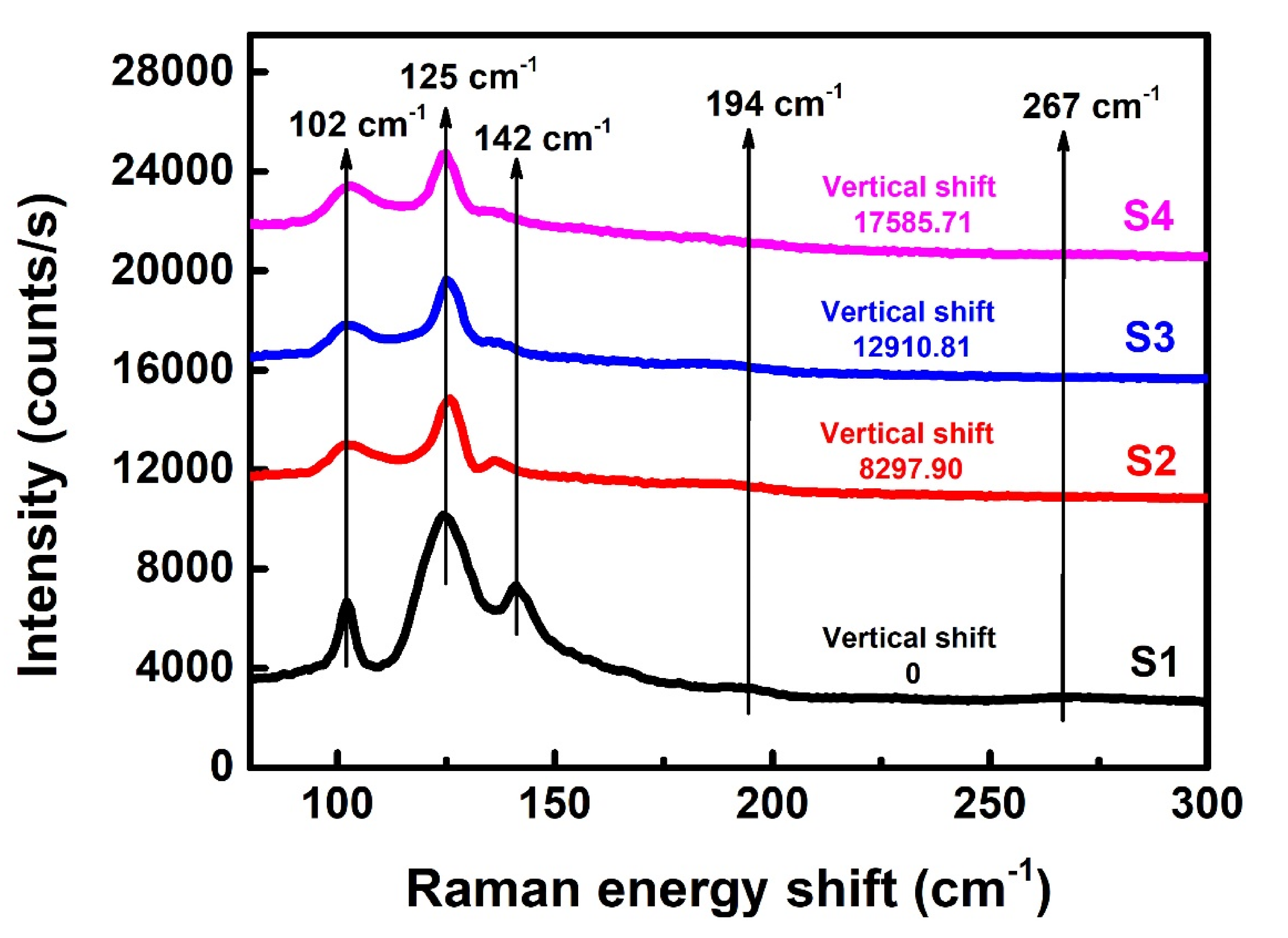

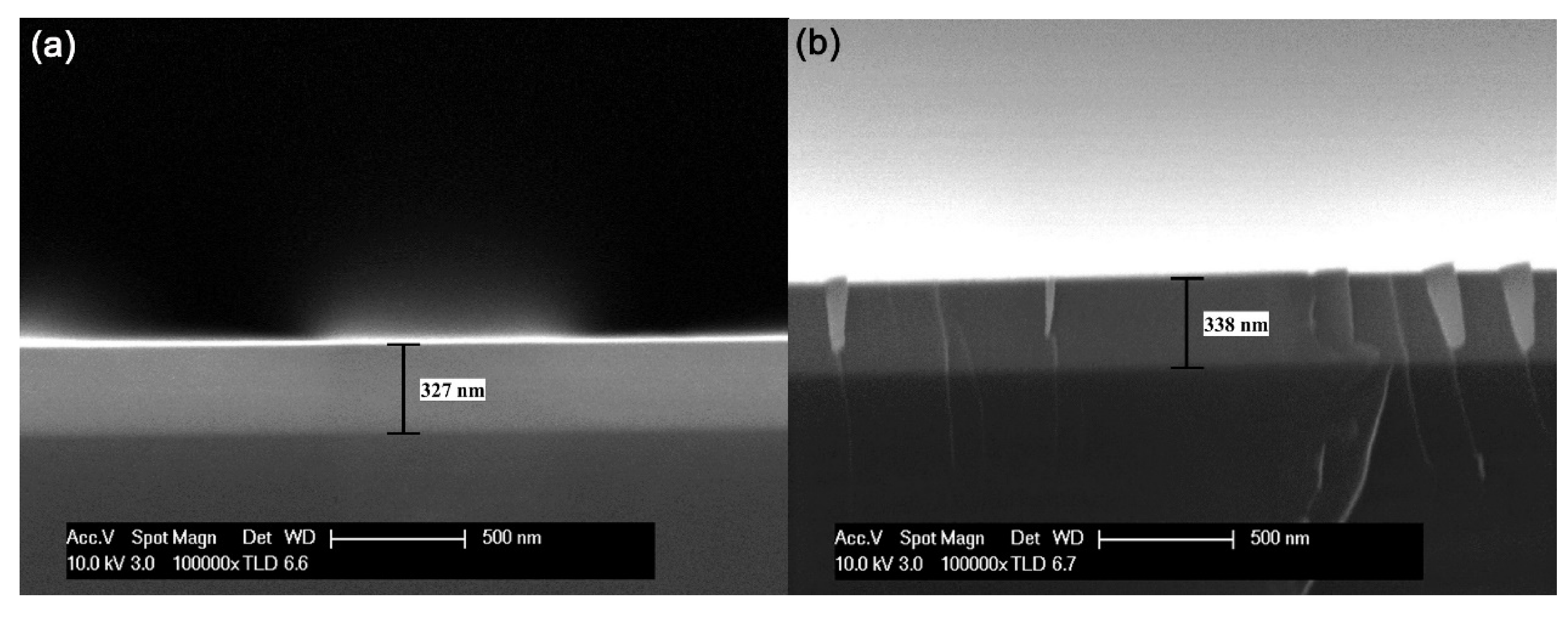
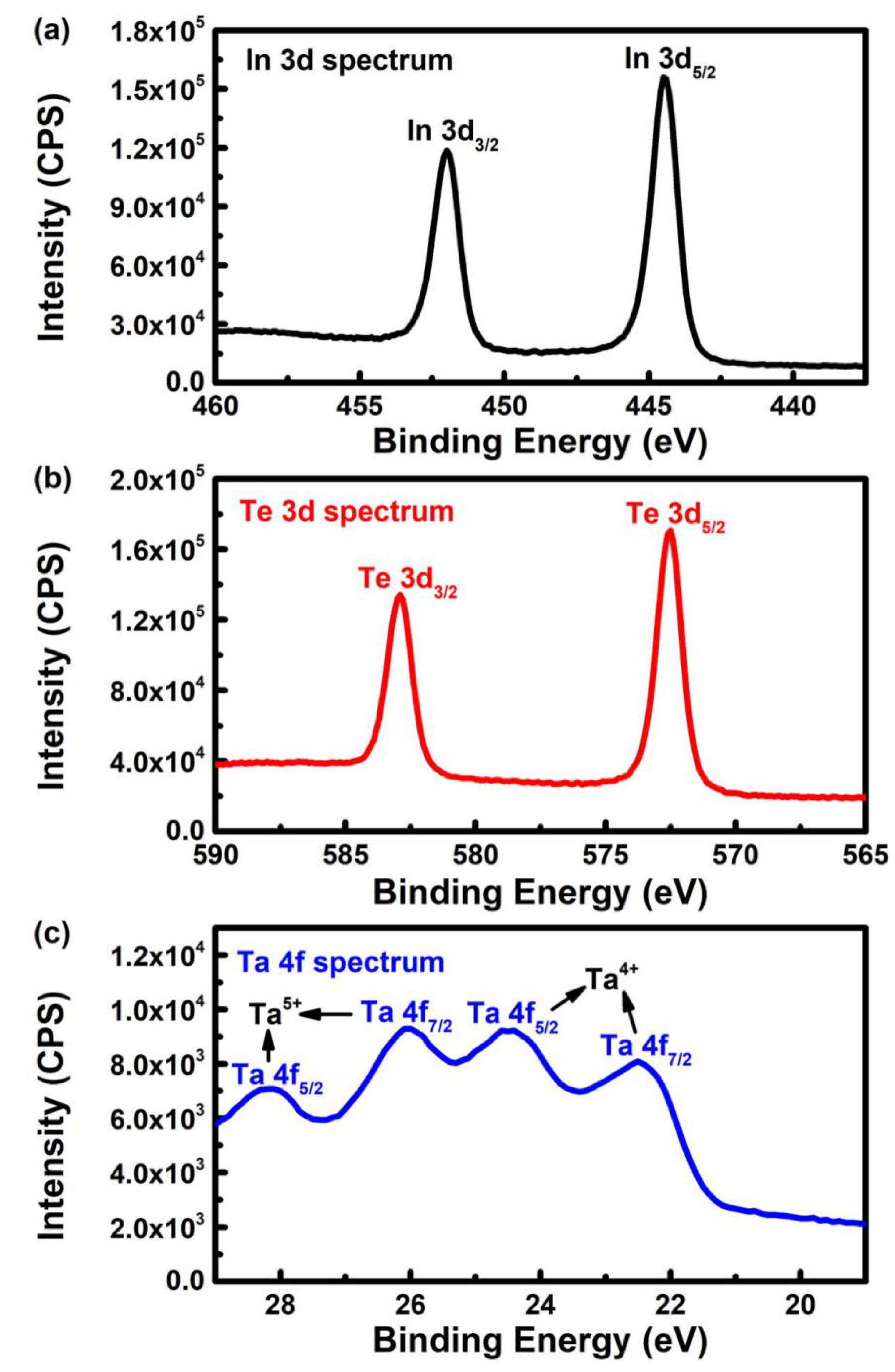

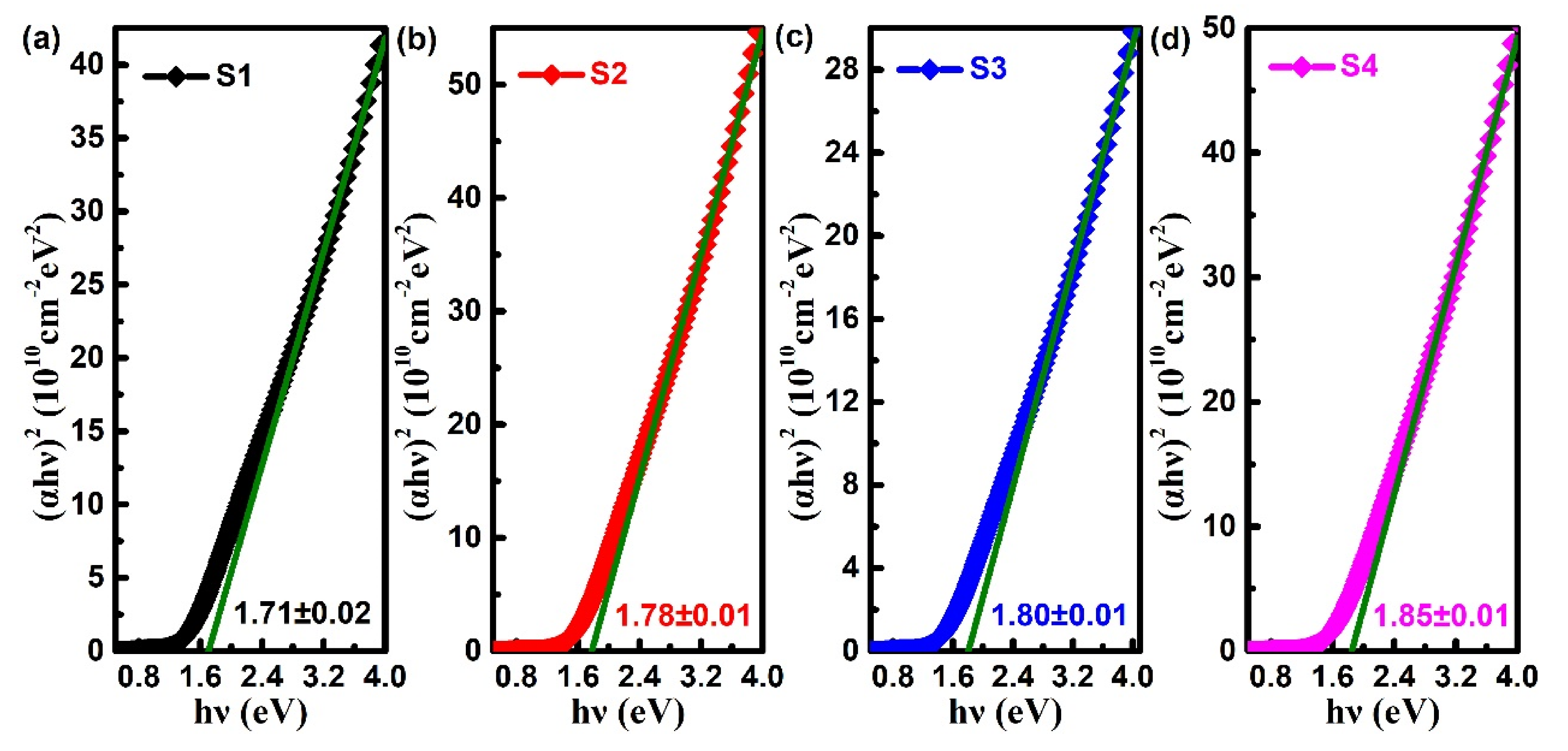

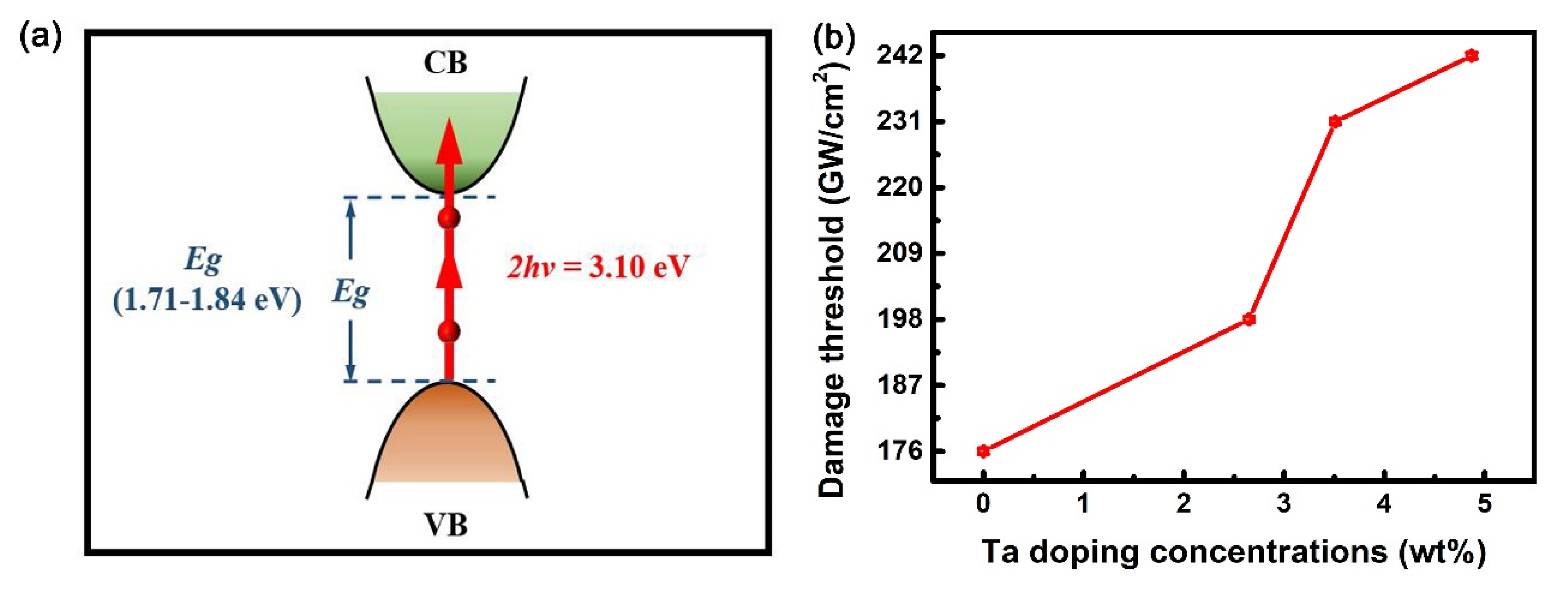
| Sample | InTe Power (W) | Ta Power (W) | FWHM (degree) | Crystallite Size (nm) |
|---|---|---|---|---|
| S1 | 200 | 0 | 0.2142 ± 0.0052 | 38.2 ± 0.8 |
| S2 | 200 | 15 | 0.3167 ± 0.0078 | 25.8 ± 0.6 |
| S3 | 200 | 20 | 0.3520 ± 0.0079 | 23.2 ± 0.5 |
| S4 | 200 | 25 | 0.4144 ± 0.0110 | 19.7 ± 0.5 |
| Reference | Characteristic Wavenumbers (cm−1) | |||||||||
|---|---|---|---|---|---|---|---|---|---|---|
| This Work | -- | -- | 102 ± 1 | 125 ± 1 | 142 ± 1 | -- | -- | 194 ± 1 | -- | 267 ± 1 |
| Te [26] | -- | -- | 105 | 123 | 143 | -- | -- | -- | -- | -- |
| Te [27] | -- | -- | -- | 120 | 140 | -- | 176 | -- | -- | 260 |
| InTe [28] | 46 | 86 | -- | 126 | 139 | -- | -- | -- | -- | -- |
| In2Te3 [29] | -- | -- | 103 | 125 | 142 | 157 | -- | 194 | 225 | -- |
| CuInTe2 [30] | -- | -- | -- | 123 | 143 | -- | 171 | -- | 220 | 267 |
| Sample | Ta Power (W) | In (wt.%) | Te (wt.%) | Ta (wt.%) | Thickness (nm) |
|---|---|---|---|---|---|
| S1 | 0 | 51.07 | 48.93 | 0 | 306 ± 1 |
| S2 | 15 | 50.19 | 47.16 | 2.65 | 327 ± 1 |
| S3 | 20 | 48.12 | 48.37 | 3.51 | 338 ± 1 |
| S4 | 25 | 49.31 | 45.81 | 4.87 | 356 ± 1 |
| Sample | Leff (nm) | β (cm/GW) | σ2 (GM) |
|---|---|---|---|
| S1 | 97.4 ± 0.05 | 526.40 ± 0.27 | 89.42 ± 0.05 |
| S2 | 117.2 ± 0.08 | 343.55 ± 0.22 | 58.35 ± 0.04 |
| S3 | 125.5 ± 0.09 | 293.68 ± 0.20 | 49.89 ± 0.03 |
| S4 | 127.0 ± 0.07 | 281.88 ± 0.17 | 47.89 ± 0.03 |
© 2020 by the authors. Licensee MDPI, Basel, Switzerland. This article is an open access article distributed under the terms and conditions of the Creative Commons Attribution (CC BY) license (http://creativecommons.org/licenses/by/4.0/).
Share and Cite
Liu, C.; Yuan, Y.; Zhang, X.; Su, J.; Song, X.; Ling, H.; Liao, Y.; Zhang, H.; Zheng, Y.; Li, J. Ta Doping Effect on Structural and Optical Properties of InTe Thin Films. Nanomaterials 2020, 10, 1887. https://doi.org/10.3390/nano10091887
Liu C, Yuan Y, Zhang X, Su J, Song X, Ling H, Liao Y, Zhang H, Zheng Y, Li J. Ta Doping Effect on Structural and Optical Properties of InTe Thin Films. Nanomaterials. 2020; 10(9):1887. https://doi.org/10.3390/nano10091887
Chicago/Turabian StyleLiu, Chunmin, Yafei Yuan, Xintong Zhang, Jing Su, Xiaoxiao Song, Hang Ling, Yuanjie Liao, Hao Zhang, Yuxiang Zheng, and Jing Li. 2020. "Ta Doping Effect on Structural and Optical Properties of InTe Thin Films" Nanomaterials 10, no. 9: 1887. https://doi.org/10.3390/nano10091887
APA StyleLiu, C., Yuan, Y., Zhang, X., Su, J., Song, X., Ling, H., Liao, Y., Zhang, H., Zheng, Y., & Li, J. (2020). Ta Doping Effect on Structural and Optical Properties of InTe Thin Films. Nanomaterials, 10(9), 1887. https://doi.org/10.3390/nano10091887






